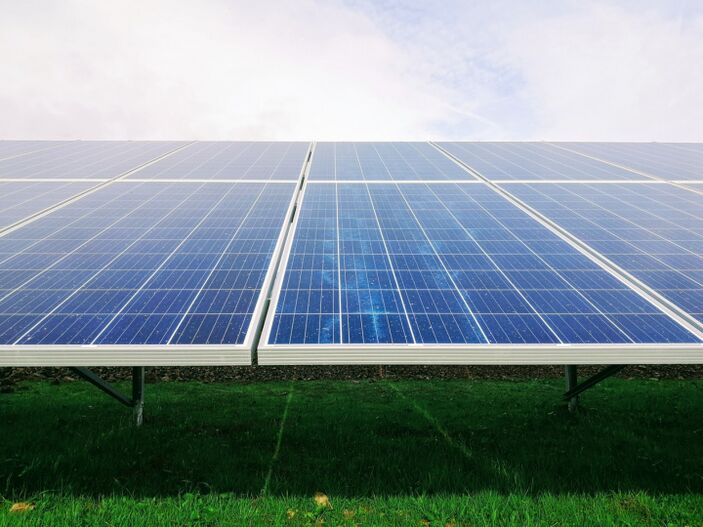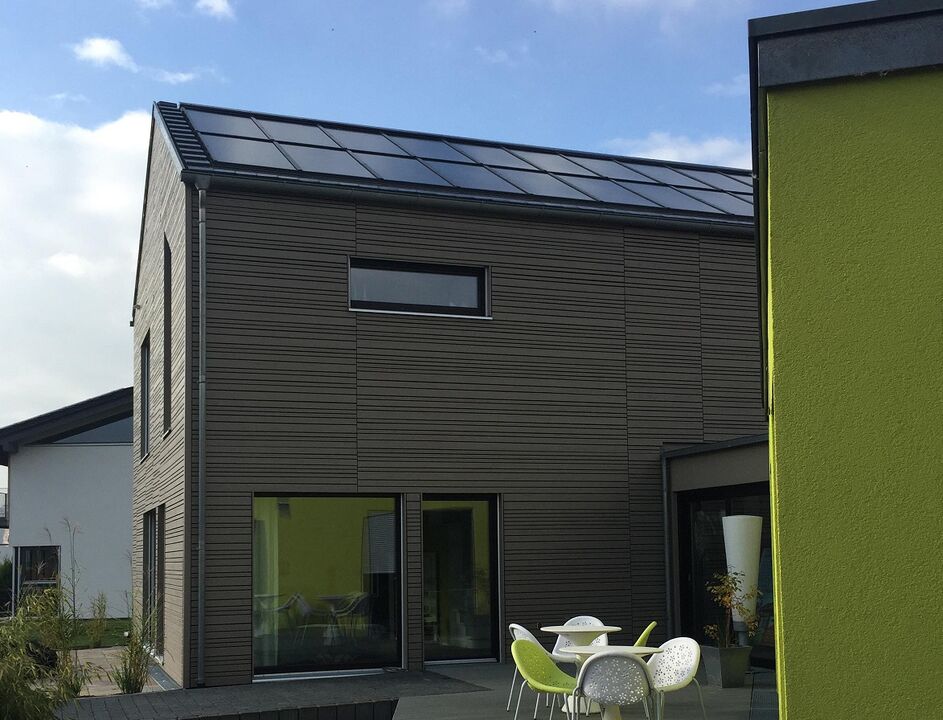
Unlike the powerful and expensive heating system that ordinary homes are equipped with, an energy-efficient home does not burn fuel or convert electricity from the grid into heat (except in cases of critical temperature drops). Such a house tenaciously retains within it - thanks to careful thermal insulation, recovery ventilation and the optimal position of the building - the so-called passive heat. And anything can be used as a source of this passive energy:
- direct sunlight penetrating through windows;
- heat generated by household appliances, but also by residents and pets;
- and, of course, devices whose main function is to provide solar energy to the house: solar panels (batteries), which we will talk about.
Solar panels fit harmoniously into a passive house, as they fully respect the fundamental principle of its construction: using renewable energy from the environment.

The operating principle of solar panels and their interaction with other home systems
- The operation of solar panels is based on the conversion of the thermal radiation that hits the silicon wafers into electrical energy;
- Solar panels allow you to use solar energy to run household appliances, ventilation systems and (partially) heating;
- If the capacity of solar panels is greater than household needs, the excess energy can be used in systems to store and convert electricity.
- If the demand for electricity exceeds the capacity of the panels, the missing part can be obtained from the grid (network solar station option) or from a liquid fuel generator (autonomous solar station).
Types of solar modules
The classification of photovoltaic systems is carried out according to the criteria of the materials and designs used. Solar batteries are:
- In the form of silicon panels (the most common, best performing and most expensive), efficiency - up to 22%; They are produced in three subtypes: monocrystalline (the most reliable), polycrystalline and amorphous; in the first two positions pure silicon is used, in the third silicon hydrogen, which is applied to the substrate;
- Film - made with cadmium telluride, copper-indium selenide and polymers. They have a lower price, but also lower performance (efficiency 5-14%), so to adapt the battery to the "appetites" of the house it will be necessary to increase the area that receives the radiation.
The consumer properties of solar panels are described by the following characteristics:
- Power.The larger the area of the solar panel, the greater its power; To generate energy of 1 kWh/day in summer, approximately 1. 5 m2 of solar panels will be needed. The most efficient power occurs when the rays fall perpendicularly onto the battery surface, which cannot be guaranteed constantly, so changing the panel's performance during daylight hours is a natural process. To ensure that in spring and autumn you get the necessary amount of energy, you need to add about 30% to this surface area;
- Efficiency(efficiency) of modern solar panels - on average about 15-17%;
- Battery life and power loss over time. Manufacturers, as a rule, provide a guarantee for the operation of solar panels for 25 years, promising a reduction in power during this period of no more than 20% of the original (for some manufacturers, the duration varies between 10-25 years with a guarantee power reduction not exceeding 10%). Crystalline modules are the most durable, their estimated lifespan is 30 years. The world's first solar battery has been in operation for over 60 years. The decrease in the production of solar modules itself is mainly due to the gradual destruction of the sealing film and the opacification of the layer between the glass and the solar cells - due to humidity, ultraviolet radiation and temperature changes;
- Battery included, which ensures the operation of the panel at night, is a good addition to the capabilities of the solar generator. The battery usually lasts less than the solar module itself, on average 4-10 years;
- Additional nodes available– as a voltage stabilizer, a battery charge regulator, an inverter (DC to AC 220 V converter for home use) make the operation of the device and its integration into the "Smart Home" system more convenient;
- Battery cost– directly depends on its surface area: the more powerful the device, the more expensive it is. Moreover, foreign-made panels are even cheaper than domestic ones, since solar panels are more popular there than in our country. But when comparing the prices of our devices and imported ones, it is necessary, first of all, to compare the operational efficiency of solar panels with each other - here domestic manufacturers get good efficiency indicators - up to 20%.
Choice and use of photovoltaic batteries
When choosing solar panels for a private home, the main thing is based on the load they will have to bear. Furthermore, it is necessary to refer to the geometry of the house and the planning of preventive maintenance activities, which together require careful consideration of the following aspects:
- Daily energy consumption of devices expected to be powered by solar energy (room lighting, domestic electrical appliances, safety and automation devices, etc. ). It should be borne in mind that charging and discharging batteries also consumes energy (about 20%), and additional equipment will also have its own losses (for example, in an inverter on average - 15-20%);
- The ratio of the required dimensions of the working panels to the corresponding areas of the roof and its geometry;
- The ability to clean the working surfaces of batteries from dirt, snow and other factors that affect the operation of photo converters.
Important points in the operation of solar panels
- Avoid physical damage to the panel (scratches and damage to the integrity of the protective film can lead to short circuits and/or corrosion);
- In harsh climatic conditions, it is recommended to equip solar stations with windproof structures;
- Regular inspections, cleaning and maintenance are mandatory.
Cost and amortization of solar panels
For the central area of our country, each kilowatt of solar panel power generates the following amount of energy:
- in summer - 5 kWh/day (May-August);
- in spring and autumn - 3-4 kWh/day (March-April, September-October);
- in winter - 1 kWh/day.
When calculating the costs of an autonomous solar station, in addition to the cost of one unit of energy generated by the panels (about 60 rubles per 1 W), it is necessary to take into account the cost of additional equipment: from fasteners and wiring to batteries, protection devices and inverters (which represents at least 5% of the total cost, but prices can vary significantly, depending on the manufacturer and power).
According to expert recommendations, the optimal costs for a year-round solar system are achieved using the "summer option plus standby electric generator" scheme. True, the generator will have to be turned on in spring and autumn, not to mention winter (solar batteries are never designed to be fully charged in the winter season).
When calculating the payback period of a solar energy system, its power is compared with the parameter taken as a basis. In a grid solar station these are electricity tariffs; in the case of an autonomous solar system this is the cost of the energy produced by a liquid fuel electric generator. The reimbursement is estimated based on the fact that a 1 kW solar battery will produce approximately 1000 kWh of energy per year.
If we consider the average price of 1 kWh of electricity equal to 5 rubles, the payback period for a grid solar station will be: 80, 000 rubles / 5 rubles * 1000 kWh = 16 years.
With a 30-year guarantee for a grid solar system, reimbursement (at the rate of 5 rubles/kWh) will take place within 16 years, and in the next 14 years electricity will be provided free of charge.
As for an autonomous solar system, strictly speaking, the amount of energy produced per year will be less than the expected 1000 kWh, which it shares with the electric generator. But for rough calculations, it is not necessary to reduce this number, to approximately take into account the increase in specific fuel consumption that occurs when the generator is partially (that is, periodically, not constantly) loaded. So the payback period of the autonomous system (based on the cost of energy produced by the liquid fuel generator - 25 rubles per 1 kWh) looks like this: 150, 000 rubles / 25 rubles * 1000 kWh = 6 years.
In addition to technical indicators, the efficiency of solar panels that are part of an autonomous solar system is confirmed by their payback period, which is 6 years.
Rates are not reduced
But the examples of solar energy systems provided suggest that tariffs can now be "frozen" individually and you can start saving by taking advantage of the capabilities of photovoltaic panels. You just need to buy them from market-tested branded manufacturers so that their parameters are predictable in both design and operation.
And it is better to address issues such as: already at the design stage of a highly energy efficient house:
- ensure that the south facade is not shaded;
- selection of the angle of inclination of the roof and the working surfaces of the panels;
- correct orientation of the house with respect to the cardinal points;
- prevent shading of the working areas of solar panels, their clogging with tree leaves, etc.

In this case, all parameters will be optimally connected to each other and the most efficient operation of solar panels for a particular structure will be ensured.

























